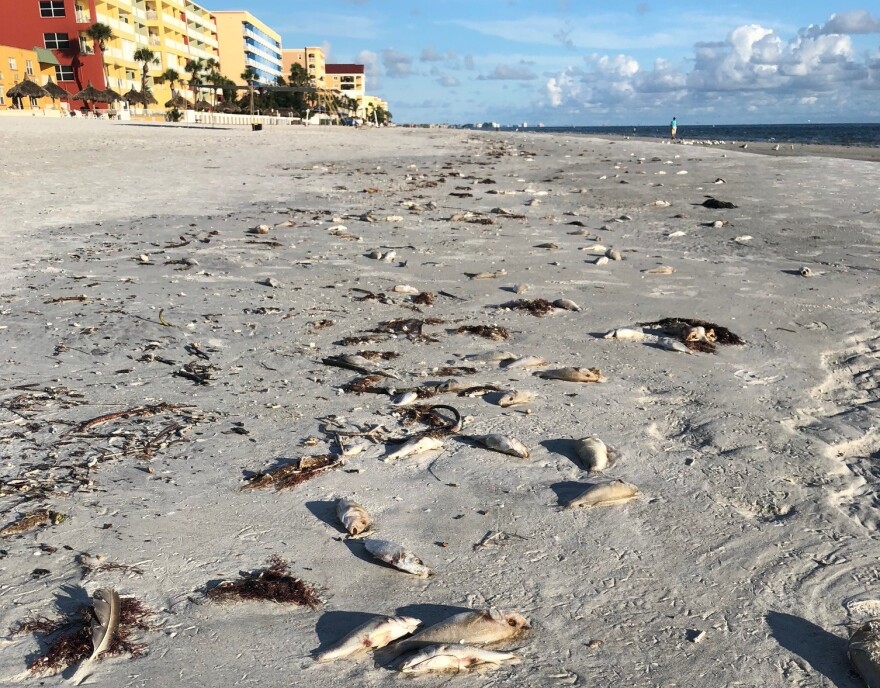That humans provide fuel for red tides that makes the smelly fish-killing events stronger and last longer has long been anecdotal. Now, researchers looking at Southwest Florida have explained that the correlation exists.
Environmental researchers led by the University of Florida’s Center for Coastal Solutions documented the link after studying a decade of red tide data from the Caloosahatchee River, Charlotte Harbor, and the surrounding watersheds including the coasts of Charlotte and Lee counties.
The findings are published in the June issue of Science of the Total Environment, which is a peer-reviewed journal and is published by the same company that produces both The Lancet and Cell.
“While red tide blooms develop naturally, we took a long view and found evidence that human activity has helped fuel coastal blooms in this estuary to varying extents between 2012 and 2021,” said Miles Medina, lead author of the study and a research scientist at UF’s Center for Coastal Solutions.
Finding a link between human activity and red tide blooms has been challenging for researchers because of the complexity of the blooms and the many factors that contribute to them, according to the Sanibel-Captiva Conservation Association.
Eric Milbrandt, who is SCCF’s marine lab director, was involved in the study and provided local knowledge.
"There has been an assumption that nutrient runoff from agriculture, fertilizer, and septic systems are used by the dinoflagellate that causes red tide blooms,” he said. “There is now another piece of evidence linking red tide bloom intensity to these human activities and nitrogen sources specifically.”
The association provided a glimpse into how the researchers linked nitrogen inputs, from both inland and coastal sections of the watershed, to eventual red tide intensity.
They started their analysis at the Kissimmee River, many sections of which had been dug into a straightened waterway in the 1900s during misguided efforts to control water coming from the growing Orlando suburbs. In recent years, that work was largely undone to restore the Kissimmee River’s original meandering flow and replace wetlands, which allows a huge amount of water to meander through the watershed in hopes that it can be naturally de-polluted.
Water bound for the River of Grass flows next into Lake Okeechobee, which has been polluted by fertilizer runoff from development south of Orlando and large agricultural operations around the lake. The study’s authors then researched the flow from the big lake into the Caloosahatchee through a river-leveling series of locks starting in Moore Haven.
That route concentrates the bad nutrients in the water to a level that consistently fed the naturally-occurring blooms along the Southwest Florida coast, the study found.
“This study confirms that nitrogen loads can in fact make red tide last longer,” Christine Angelini, director of the Center for Coastal Solutions, told SCCF. “However, it is important not to jump to conclusions and immediately assign ‘blame’ for red tide events to a particular land use because other factors play a role as to the level of impact human activity will have.”
Dave Tomasko, a long-time researcher of coastal systems on Florida’s West Coast who is now director of the Sarasota Bay National Estuary Program, explained that for over a decade the State of Florida has acknowledged that nitrogen loads from the Caloosahatchee River are too high.
“Our paper simply indicates that there are additional benefits to reducing nitrogen loads, such as a reduced enhancement of red tides that arrive on our coast,” he said. “Basically, if we do the things that the state has already determined need to be done, we would not only benefit oxygen and water clarity and seagrass meadows in this estuary, but also likely help to reduce the impacts of future red tides."
Read the entire study in the journal Science of the Total Environment here.
Environmental reporting for WGCU is funded in part by VoLo Foundation, a non-profit with a mission to accelerate change and global impact by supporting science-based climate solutions, enhancing education, and improving health.
Sign up for WGCU's monthly environmental newsletter, the Green Flash, today.
Copyright 2022 WGCU. To see more, visit WGCU. 9(MDAyNDY5ODMwMDEyMjg3NjMzMTE1ZjE2MA001))







